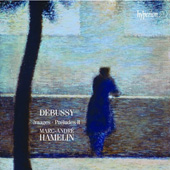
DEFINITIVE RECORDINGS

IMPRESSIONISM: In music, a style initiated by French composer Claude Debussy at the end of the 19th century. The term, which is somewhat vague in
reference to music, was introduced by analogy with contemporaneous French painting; it was disliked by Debussy himself. Elements often termed "impressionistic"
include static harmony, emphasis on instrumental timbres that create a shimmering interplay of "colours," melodies that lack directed motion, surface
ornamentation that obscures or substitutes for melody, and an avoidance of traditional musical form. {Encyclopædia Britannica}
Claude Debussy (1862-1918) stands at the end of the long century of romanticism and, by that same token, could be seen as one of the first
instigators of "modern" music, not by expanding on or, experimenting with the standards of the past, but rather by breaking away from them. He avoided the use
of the sonata-form, of strict tonality, and momentum based on time-signature. His piano works don't require an advanced technique as a means to an end, and
the beauty of his music stems from its lack of structural complexities. Which is why I was astounded by how a virtuoso and technically brilliant pianist like
Marc-André Hamelin could be so congenial with the spirit of this music. One listen of Reflets dans l'eau, the first piece
on this CD, was enough to convince me once again that Hamelin is a musical chameleon. From Godowsky to Debussy and everything in between, there is nothing
he can't master and perform superlatively. His expressive touches and relaxed sense of momentum add to the ephemeral nature of this music. In Debussy's piano
works, even the printed score, with its odd and unusual chord structures, unexpected harmonic intervals, and lack of formal direction or A-B-A form, leaves the
pianist with plenty of room for interpretation and expressive freedom. Even in a piece as obviously picturesque as La Puerta del Vino,
Marc-André Hamelin manages, by dynamically downplaying the main melody, to touch the listener with a sense of exotic mystery. I've never heard
General Lavine, Excentric so clearly articulated and accented, or such an adequately moody, atmospheric and evocative interpretation of
La terrasse des audiences du clair de lune as this one. And of course, who else but Hamelin would play Feux d'artifice
with so much blinding brilliance and sparkle.
Highly recommended for Debussy and Hamelin fans alike. It definitely leaves an impression (pun intended).
Jean-Yves Duperron - November 2014